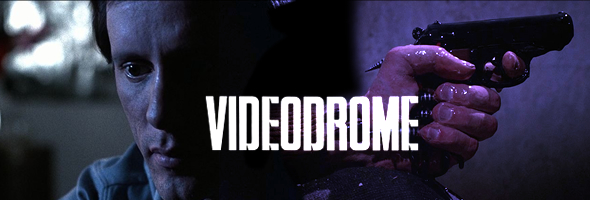
Color, 1983, 89m.
Directed by David Cronenberg
Starring James Woods, Deborah Harry, Sonja Smits, Les Carlson, Jack Creley, Peter Dvorsky
Arrow (Blu-ray& DVD) (UK RB/R2 HD/PAL), Criterion (Blu-Ray & DVD) (US RA/R1 HD/NTSC) / WS (1.85:1) (16:9), Universal (US R1 NTSC) / WS (1.85:1
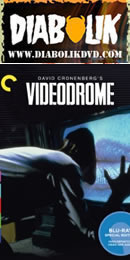
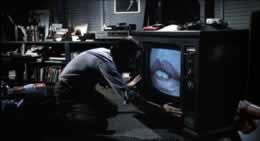 Underground TV porn entrepreneur Max Renn (Woods) stumbles upon a covert signal depicting a woman being horribly tortured. Intrigued, he uses his connections to track down the origin of the program, dubbed "Videodrome," while becoming sexually involved with kinky social commentator Nicki Brand (Harry). Renn's partner, Harlan (Dvorsky), explains the signal originates from Pittsburgh, sending Nicki on a quest to appear on the program - which may or may not be real. Further exposure to the Videodrome signal results in nightmarish hallucinations and bodily transformations within Max, all possibly linked to a mysterious media critic named Brian O'Blivion (Creley) who only appears on a television screen. O'Blivion's icy daughter Bianca (Smits) also seems to be engaged in a strange battle of wills with conservative eye wear guru Barry Convex (Carlson), whose own insidious motives provide a key to the mystery of Videodrome.
Underground TV porn entrepreneur Max Renn (Woods) stumbles upon a covert signal depicting a woman being horribly tortured. Intrigued, he uses his connections to track down the origin of the program, dubbed "Videodrome," while becoming sexually involved with kinky social commentator Nicki Brand (Harry). Renn's partner, Harlan (Dvorsky), explains the signal originates from Pittsburgh, sending Nicki on a quest to appear on the program - which may or may not be real. Further exposure to the Videodrome signal results in nightmarish hallucinations and bodily transformations within Max, all possibly linked to a mysterious media critic named Brian O'Blivion (Creley) who only appears on a television screen. O'Blivion's icy daughter Bianca (Smits) also seems to be engaged in a strange battle of wills with conservative eye wear guru Barry Convex (Carlson), whose own insidious motives provide a key to the mystery of Videodrome.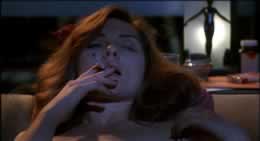 American viewers at least were largely oblivious to the rich, disturbing themes running through all of his films. Videodrome ruffled more than a few feathers at Universal (who was certainly gutsier than usual that year thanks to Cat People and Conan the Barbarian), and when the MPAA demanded cuts to its extreme sex and violence, the writing was on the wall. The film suffered even further when a studio exec with an aversion to sex toys demanded further cuts to the early "Samurai Dreams" sequence, resulting in a compromised edition virtually thrown away in theaters among more palatable fare like E.T.. However, its influence grew over the years thanks to its unrated release on videotape (a real rarity in those days and probably the second of its kind after Dressed to Kill), cable screenings, a growing cult following, and Cronenberg's Hollywood ascension thanks to The Fly. Of course, the themes of Videodrome have become more vitally important with each passing year thanks to the advent of the Internet (an artificial public consciousness if there ever was one), the modern news syndrome of bald-faced manipulation of social perception, and cinematic acceptance of multi-layered "postmodernism" in such offshoots as Fight Club and Being John Malkovich. What once seemed a hopelessly dense, oddball look at the dawning video age has proven to become a prophet of a new age (or a New Flesh if you will) with people almost inseparable from the computers and televisions with which they share most of their waking hours. Offering one of his career-best performances, Woods is perfect as the nervous, confused porn hound; meanwhile, in her limited screen time, Harry (looking stunning with auburn hair) easily matches him with an uninhibited, indelible performance complete with a ear-piercing and cigarette-burning scenes no viewer will ever forget. Most of Cronenberg's regular collaborators are present behind the camera and do exceptional work, with Howard Shore in particular unleashing a chilly, complex score that almost makes his work on Scanners sound reassuring.
American viewers at least were largely oblivious to the rich, disturbing themes running through all of his films. Videodrome ruffled more than a few feathers at Universal (who was certainly gutsier than usual that year thanks to Cat People and Conan the Barbarian), and when the MPAA demanded cuts to its extreme sex and violence, the writing was on the wall. The film suffered even further when a studio exec with an aversion to sex toys demanded further cuts to the early "Samurai Dreams" sequence, resulting in a compromised edition virtually thrown away in theaters among more palatable fare like E.T.. However, its influence grew over the years thanks to its unrated release on videotape (a real rarity in those days and probably the second of its kind after Dressed to Kill), cable screenings, a growing cult following, and Cronenberg's Hollywood ascension thanks to The Fly. Of course, the themes of Videodrome have become more vitally important with each passing year thanks to the advent of the Internet (an artificial public consciousness if there ever was one), the modern news syndrome of bald-faced manipulation of social perception, and cinematic acceptance of multi-layered "postmodernism" in such offshoots as Fight Club and Being John Malkovich. What once seemed a hopelessly dense, oddball look at the dawning video age has proven to become a prophet of a new age (or a New Flesh if you will) with people almost inseparable from the computers and televisions with which they share most of their waking hours. Offering one of his career-best performances, Woods is perfect as the nervous, confused porn hound; meanwhile, in her limited screen time, Harry (looking stunning with auburn hair) easily matches him with an uninhibited, indelible performance complete with a ear-piercing and cigarette-burning scenes no viewer will ever forget. Most of Cronenberg's regular collaborators are present behind the camera and do exceptional work, with Howard Shore in particular unleashing a chilly, complex score that almost makes his work on Scanners sound reassuring. 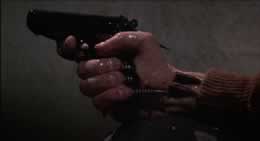 Video extras are plentiful and should keep fans coming back repeatedly after each viewing of the film. A 2000 Cronenberg short film, "Camera," was created as one of the commissioned "Preludes" celebrating the Toronto Film Festival's 25th Anniversary. Carlson takes center stage here, delivering a fascinating and sometimes chilling monologue about the parasitic qualities of cameras while a group of youngsters prepare to film him. Shot on video except for a sudden, appropriate shift to 35mm at the end, it's a haunting six minutes that raises as many questions as it answers. Special effects supervisor Michael Lennick delivers a solid 27-minute documentary, "Forging the New Flesh," in which he and other effects workers (including Baker) recall the making of the film accompanied by fantastic video footage of the crew at work on the film. There's also an amusing, extended Christmas Eve anecdote that lends a whole new level of appreciation to the gut-busting final moments of the film. "Effects Men" offers audio recollections by Baker and Lennick about the various complicated assignments within the film, divided into four easy-to-digest chunks. "Bootleg Video" features three unedited looks at video content within the film, unedited and featuring previously unseen footage: "Samurai Dreams" (complete with a soft sex scene at the end), "Transmissions from Videodrome" (which is rather difficult to watch divorced from the film's context and lends credence to the claim that Emanuelle in America was one of Cronenberg's inspirations), and "Helmet-Cam Test," a series of alternate versions of Renn's first experience inside the glowing helmet. All feature commentaries involving various combinations of Cronenberg, Irwin, and Lennick, plus the priceless disclaimer, "All vestiges of the Videodrome signal have been filtered out to ensure tumor-free viewing." Horror fans will jump for joy upon seeing "Fear on Film," a half-hour roundtable discussion apparently designed as a promotional tool by Universal. Three directors on Uni projects - Cronenberg, John Carpenter, and John Landis - sit with future director Mick Garris for a discussion of the horror genres, the ratings system, censorship, and the appeal of fear. It's a wonderful time capsule and reveals how little has changed in the industry over the past decades. The marketing section features three trailers (one fairly good, the other two variations on that awful animated version), "The Making of Videodrome" (Garris' 1982 behind-the-scenes promotional short featuring interviews with Cronenbeg and Woods plus plenty of behind-the-scenes footage, some of which trickled into "Forging the New Flesh"), a marketing gallery of posters and lobby cards, and an array of publicity stills.
Video extras are plentiful and should keep fans coming back repeatedly after each viewing of the film. A 2000 Cronenberg short film, "Camera," was created as one of the commissioned "Preludes" celebrating the Toronto Film Festival's 25th Anniversary. Carlson takes center stage here, delivering a fascinating and sometimes chilling monologue about the parasitic qualities of cameras while a group of youngsters prepare to film him. Shot on video except for a sudden, appropriate shift to 35mm at the end, it's a haunting six minutes that raises as many questions as it answers. Special effects supervisor Michael Lennick delivers a solid 27-minute documentary, "Forging the New Flesh," in which he and other effects workers (including Baker) recall the making of the film accompanied by fantastic video footage of the crew at work on the film. There's also an amusing, extended Christmas Eve anecdote that lends a whole new level of appreciation to the gut-busting final moments of the film. "Effects Men" offers audio recollections by Baker and Lennick about the various complicated assignments within the film, divided into four easy-to-digest chunks. "Bootleg Video" features three unedited looks at video content within the film, unedited and featuring previously unseen footage: "Samurai Dreams" (complete with a soft sex scene at the end), "Transmissions from Videodrome" (which is rather difficult to watch divorced from the film's context and lends credence to the claim that Emanuelle in America was one of Cronenberg's inspirations), and "Helmet-Cam Test," a series of alternate versions of Renn's first experience inside the glowing helmet. All feature commentaries involving various combinations of Cronenberg, Irwin, and Lennick, plus the priceless disclaimer, "All vestiges of the Videodrome signal have been filtered out to ensure tumor-free viewing." Horror fans will jump for joy upon seeing "Fear on Film," a half-hour roundtable discussion apparently designed as a promotional tool by Universal. Three directors on Uni projects - Cronenberg, John Carpenter, and John Landis - sit with future director Mick Garris for a discussion of the horror genres, the ratings system, censorship, and the appeal of fear. It's a wonderful time capsule and reveals how little has changed in the industry over the past decades. The marketing section features three trailers (one fairly good, the other two variations on that awful animated version), "The Making of Videodrome" (Garris' 1982 behind-the-scenes promotional short featuring interviews with Cronenbeg and Woods plus plenty of behind-the-scenes footage, some of which trickled into "Forging the New Flesh"), a marketing gallery of posters and lobby cards, and an array of publicity stills. 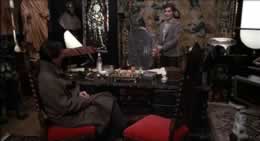 Then flex your remote fingers for another separate stills gallery section divided into "Special Effects" and "Cast and Crew," featuring an incredible barrage of photos (many from Tim and Donna Lucas) covering every possible aspect of the film. No less generous is the disc's packaging (identical for the Blu-Ray and DVD, except the former is slimmer), including a wonderful sleeve design best left unspoiled here. The thick booklet enclosure features three essays: "Make Mine Cronenberg" by Carrie Rickey (updating her Village Voice piece from 1983), Tim Lucas' "Medium Cruel: Reflections of Videodrome" (a very thorough discussion of his own observations on the set during filming and afterwards), and "That Slithery Sense of Unreality" by Gary Indiana, a more symbolic reading.
Then flex your remote fingers for another separate stills gallery section divided into "Special Effects" and "Cast and Crew," featuring an incredible barrage of photos (many from Tim and Donna Lucas) covering every possible aspect of the film. No less generous is the disc's packaging (identical for the Blu-Ray and DVD, except the former is slimmer), including a wonderful sleeve design best left unspoiled here. The thick booklet enclosure features three essays: "Make Mine Cronenberg" by Carrie Rickey (updating her Village Voice piece from 1983), Tim Lucas' "Medium Cruel: Reflections of Videodrome" (a very thorough discussion of his own observations on the set during filming and afterwards), and "That Slithery Sense of Unreality" by Gary Indiana, a more symbolic reading.